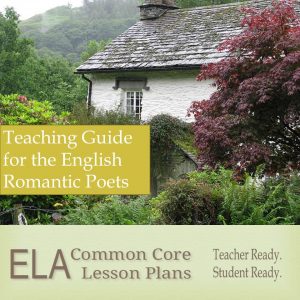Here’s a brief look at British Romantic poets and a couple of poems.

Yes, you can spend multiple class periods on poetry without the dreaded 2-minute reading followed by 49 minutes of stammering. The British Romanticism Teaching Guide includes an overview of British Romanticism and an analysis of selected poems by William Blake, William Wordsworth. Samuel Taylor Coleridge, Lord Byron, Percy Shelley and John Keats.
Six Famous British Romantic Poets
- William Blake - “The Tyger,” “The Lamb,” “The Marriage of Heaven and Hell,” “The Chimney Sweeper,” and “The Clod and the Pebble” are his more popular selections. Links to an analysis of these poems can be found to the right.
- William Wordsworth - “I Wandered Lonely as a Cloud,” “Tintern Abbey,” “Ode to Duty,” “We are Seven,” “She Dwelt among the Untrodden Ways,” and “The World is too much with us” are but a few of hundreds of poems by Wordsworth.
- Samuel Taylor Coleridge - Coleridge was fascinated with the supernatural as evidenced by his classic, “Rime of the Ancient Mariner.”
- John Keats - The most popular Romantic poet wrote “Ode on a Grecian Urn,” “La Belle Dame sans Merci,” “Ode to a Nightingale,” “Ode on Melancholy,” and much more.
- Percy Bysshe Shelley - “Mutability” and “Ode to the West Wind” are his more famous poems. “Ozymondias” is short and powerful.
- Lord Byron - George Gordon called himself Lord Byron. “Prometheus,” and “The Destruction of Sennacherib” are a couple of his better short works. His long poems “Child Harolde’s Pilgrimage” and “Don Juan” are considered his masterpieces.
Analysis of Wordsworth’s “Ode: Intimations of Immortality”

Imagine having 11 complete poetry units with handouts and lesson plans completed. You don’t need to imagine. These units are teacher ready and student ready. Just print, make copies, and accept accolades from colleagues and students.
This analysis of “Ode: Intimations of Immortality” is but one interpretation of Wordsworth’s classic.
- Let’s begin with the title: Intimations means something marked by close association. An ode is a tribute. The poem therefore is a tribute to something that is closely associated with immortality or something that reminds the poem’s speaker of immortality, in this case, childhood and nature.
- There is neither a uniform stanza form nor a uniform rhyme scheme. We’ll confine our structural analysis of the poem to the first stanza:
- Rhyme Scheme - ababacddc - the rhyming pattern turns after line 5. The perception of nature also turns at the end of line 5. Coincidence? No.
- Lines 1-5 recollect the poet’s childhood joy of viewing nature “apparell’d in celestial light” (4).
- Lines 6-9 lament the poet’s loss and recognizes “The things which I have seen I see no more” (9).
- The first stanza serves as an introduction to the rest of the poem. The speaker ponders how this joy has been lost and what has caused it.
- The second stanza provides an example of what the poet laments in the latter half of stanza 1: even though he sees the beauty of nature, he recognizes that something has been lost, “That there hath passed away a glory from the earth” (18).
- The third stanza marks a change in mood. The speaker’s grief at what has been lost is replaced by the joy of what has been rediscovered. It comes to him while surrounded by the sights and sounds of “the heart of May,” “thou Child of Joy,” and “thou happy Shepherd-boy.”
- The next stanza celebrates the renewal brought on by Spring and youth on “This sweet May morning, / And the children are culling / On every side, / In a thousand valleys far and wide” (45-48). Another shift occurs at line 52 as the narrator gloomily reflects on what he could have had. The remainder of the poem hypothesizes what causes humans to lose their joyful approach to nature and life.
- The fifth stanza contains the most famous lines from the poem and captures Wordsworth’s philosophy on the eternal nature of the soul. Stanza 5 begins “Our birth is but a sleep and a forgetting: / The soul that rises with us our life’s Star / Hath had elsewhere its setting” (59-61) meaning that birth is not the beginning of life; it’s a passing through a veil. Although it’s a veil of forgetfulness it’s “Not in entire forgetfulness” (63). The speaker continues that the soul comes “From God, who is our home” and that “Heaven lies about us in our infancy!” (66-67). In other words infants have a recollection and a connection with God and nature that is lost as life progresses.
- The remainder of the poem chronicles man’s loss of innocence and connection with nature as he progresses and “Earth fills her lap with pleasures of her own.”
- Stanza 7 is an allusion to Shakespeare’s “Seven Ages of Man” and philosophizes that at the age of 6, boys and girls see the plan of their life set before them, an imitation of those who have gone on before them. It consists of “a wedding or a festival, / a mourning or a funeral” (94-95), business, love, strife dealings that cause man to forget his eternal nature.
- In stanza 8, the poem’s speaker compares the child to a philosopher or a prophet, one who understands eternity, and poses a simple question: why submit so much to the cares of the world and yoke yourself with things that matter little? In short, the poet laments the loss of something wonderful.
- In the 9th stanza the speaker contends that man was created for joy, but his inclination to abandon nature for the things of the world rob him of happiness.
- The final two stanzas plead for a renewal of the soul through reconnecting with nature and remembering the eternal splendor we once knew as children.
The World is too Much with Us
Getting and spending, we lay waste our powers:
Little we see in Nature that is ours;
We have given our hearts away, a sordid boon!
This Sea that bares her bosom to the moon;
The winds that will be howling at all hours,
And are up-gathered now like sleeping flowers;
For this, for everything, we are out of tune,
It moves us not.-Great God! I’d rather be
A Pagan suckled in a creed outworn;
So might I, standing on this pleasant lea,
Have glimpses that would make me less forlorn;
Have sight of Proteus rising from the sea;
Or hear old Triton blow his wreathed horn.
Brief Analysis of “The World is too Much with Us” by William Wordsworth
The following thoughts are produced by an analysis of “The World is too Much with Us” by William Wordsworth.
- Rhyme Scheme - abba abba cdcdcd - The poem is a Petrarchan or Italian Sonnet. The first eight lines present the situation or the problem. The end of line 8 is the volta, or turning. The situation is resolved in the final 6 lines.
- The volta in this poem does not solve the problem, but gives an alternative to the modern way of life. One of the tenets of Romanticism is the dangers of technology and progress. This poem is a criticism of the modern world, a world that has gotten so far away from what brings joy that the poem’s speaker would rather be an adherent to an outdated religion than continue on the same course.
